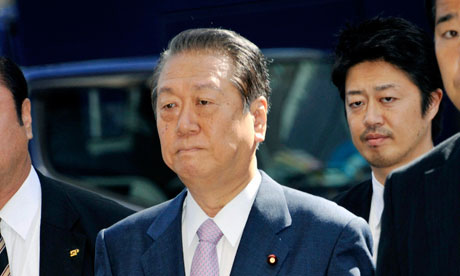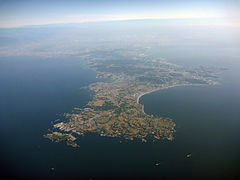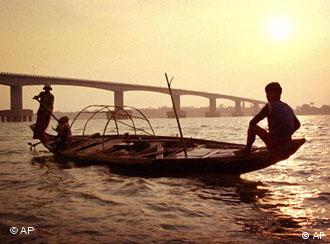In an attempt to win cooperation from opposition parties for crucial post-quake legislation, the ruling Democratic Part of Japan on July 22 admitted it would not be able to deliver on manifesto pledges made before its historic 2009 Lower House election victory.
Prime Minister Naoto Kan and the DPJ Secretary-General Katsuya Okada officially apologized to voters for the failure.
In 2009, the DPJ defeated the Liberal Democratic Party, which had governed the country almost without interruption for more than half a century, in a landslide. At the time, the LDP and its previous coalition partner New Komeito criticized the DPJ's election promises as pipe dreams.
Jun Azumi, chairman of the DPJ's Diet Affairs Committee, said the party was backing away from the manifesto to try to get cooperation from the opposition on key legislation.
"We have to pass the bill for issuance of deficit-covering government bonds (to procure funds for the recovery efforts in areas hit hard by the Great East Japan Earthquake and tsunami)," he said.
Passage of the debt-financing legislation is one of three major pieces of legislation Kan has said he wants to get through the Diet before resigning.
The other two are a second a supplementary budget and a special measures bill on renewable energies.
The second supplementary budget is expected to pass the Diet on July 25, but the LDP and New Komeito demanded a review of the manifesto as a condition for cooperation for the passage of the government bonds bill. They stipulated that Okada had to officially admit the failure to deliver on its pledges and to apologize for that failure.
Okada had a meeting with LDP Secretary-General Nobuteru Ishihara and New Komeito's Yoshihisa Inoue on July 20. In that meeting, Okada showed them a document outlining the apology.
On July 22, Okada met the two again, and handed over the document. He told reporters the LDP and New Komeito had indicated that the ruling party's apology was a step toward cooperation.
The LDP's Ishihara welcomed the move, saying the DPJ leadership had made its policy agenda more "feasible." Privately, LDP leaders appear to be calculating that the jettisoning of the manifesto will sow discord in the ruling bloc.
Ishihara pointed to emerging differences in the DPJ over its election pledge to introduce child allowances.
Criticism of Kan and Okada's concession is intensifying in the DPJ. Yukio Hatoyama, who led the party to victory in the 2009 election, said: "To pass the government bonds bill, Kan is throwing out what is most important to us."
Despite Kan and Okada's apologies, there is no guarantee that the LDP and New Komeito will cooperate on the debt financing bill.
LDP chairman Sadakazu Tanigaki said in his party's General Council meeting July 22: "If the DPJ withdraws the bill on child allowances which it publicized in the manifesto, it should dissolve the Diet and hold a Lower House election."
The LDP's vice chairman Tadamori Oshima and some other lawmakers are pursuing a different line, urging that the LDP should work to quickly meet the three conditions for Kan's resignation and cooperate with the post-Kan DPJ leadership.
Oshima told Okada in their secret meetings that if the DPJ expresses apologies for its failure to realize the manifesto, the LDP would cooperate on the government bonds bill.
Meanwhile, New Komeito will hold an emergency meeting of its leadership July 25 to decide its stance on the government bonds bill and other issues.
***
Effects of March 11 disaster still felt at Tsukiji fish market
BY EIICHIRO SUGANUMA STAFF WRITER
2011/07/24

The first skipjack tuna brought in to Kesennuma port in Miyagi Prefecture after the Great East Japan Earthquake goes on sale at the Tsukiji fish market. (The Asahi Shimbun)
The devastation caused to many fishing ports along the Sanriku and Joban coasts by the Great East Japan Earthquake has led to the loss of popular maritime products from the Tsukiji fish market.
The negative publicity arising from the accident at the Fukushima No. 1 nuclear power plant has also led to comparisons with 1954 when a fishing boat, the Daigo Fukuryu Maru, was showered by deadly radioactive fallout from the testing of a hydrogen bomb at the Bikini Atoll by the United States.
In late June, the first skipjack tuna hauled in at Kesennuma port in Miyagi Prefecture after the quake and tsunami sold for about 3,000 yen ($37) per kilogram at the Tokyo Metropolitan Central Wholesale Market in Tsukiji. The price was about three times higher than the usual level.
One middleman working at Tsukiji said the higher price was meant as a symbol of encouragement for the disaster-stricken areas.
Kesennuma port used to have the largest volume of fresh skipjack tuna brought into a Japanese port, but after the disasters only a handful of the ice companies and processing plants have resumed operations. That means the port can only handle about 50 tons of fish.
According to industry experts, the movement of schools of skipjack tuna that normally swim northward on the warm Kuroshio Current has been slower than usual this year. In late June, the skipjack tuna were still off the coast of the Boso Peninsula in Chiba Prefecture.
The convoys of fishing boats that have pursued the tuna have brought in the fish to Katsuura port in Chiba Prefecture.
If the skipjack tuna should start moving northward, a small number of ports in the Tohoku region have limits to the volume of fish that can be brought in. Under that situation, fishing boats will have to make the difficult choice of using more fuel to return to Katsuura port or to limit the amount of fish caught.
While fish from Tohoku region ports had decreased drastically after the March 11 disaster, boxes labeled with Shiogama in Miyagi Prefecture and Miyako in Iwate Prefecture have become more noticeable at the Tsukiji fish market from early June.
However, the volume of boxes is still nowhere close to average years. The general consensus among market insiders is that it will take two to three years before the volume of fish from the Tohoku region returns to normal.
According to weekly market reports at Tsukiji, in the week following March 12, the day after the quake and tsunami, the total volume of maritime products handled at the market decreased to 75 percent of the previous year.
With products from western Japan making up for the shortage of fish from the Tohoku region, the volume had recovered to about 99 percent by late April. However, the volume of products from the disaster-stricken areas continues to be close to zero.
Kenji Ando, a director with a cooperative of middlemen at Tsukiji, said, "The fish caught off the coast from Iwate to Chiba is called Sanriku-Joban products, and it is traded at comparatively higher prices than other regions. The meat of the flounder and flatfish is more firm and the popularity is high."
Some ports in the Tohoku region used to specialize in certain products.
For example, the Ukedo port in Namie, Fukushima Prefecture, was known for transporting live fish kept in tanks on the boats directly to the market. However, because the port is located within the no-entry zone established within a 20-kilometer radius of the Fukushima No. 1 plant, no work has begun to rebuild it.
An official with Otsubo Suisan Co., which serves as a middleman for live fish, said, "From now until summer, Japanese sea bass is popular. While we tried to make do with other fish, there are some restaurants that have taken items off their menus because they are unable to obtain fish from Ukedo."
Wakame seaweed from the Sanriku coast, which used to make up 80 percent of all domestic wakame sold, also cannot be found.
One company has turned to wakame from Tokushima and Aichi prefectures in an attempt to maintain its focus on domestic products, but there has also been an increase in wakame from China being handled at the Tsukiji market.
A company official said, "Many people are waiting for the return of Sanriku wakame, which is thicker and more chewy."
Some veterans of Tsukiji believe the aftereffects from the March 11 disasters may last longer than the aftereffects from Bikini Atoll in 1954.
Takashi Saito, 77, the president of Izutora, a company mainly handling tuna, was 20 at the time and helping his uncle at the company.
On April 3, 1954, the Daigo Fukuryu Maru brought in its catch to Yaizu port in Shizuoka Prefecture after it was contaminated by radiation, and some of the tuna would make its way to Tsukiji.
While there was a huge uproar then about the selling of contaminated fish, Saito said the effect on sales ended after about three months. In the current nuclear crisis, he said his company's sales had dropped by half and still had not recovered.
Because many companies at the Tsukiji fish market deal with restaurants and hotels, there is a noticeable decrease in the sales of expensive fish.
Yasuhiro Yamazaki, an executive with the fish company Yamaharu, said the negative publicity from the Fukushima nuclear accident was a major factor.
A chef at a sushi restaurant that does business with Yamaharu told Yamazaki that customers have been asking where every fish they order was caught. Some customers refuse to order sushi if the fish was caught in a prefecture close to Fukushima.
However, Yamazaki is confident that sales will eventually recover.
"The eating of fish remains strong," he said. "When I brought sashimi to a friend in the disaster-stricken area, they were very happy to receive it."















![通天閣―新・日本資本主義発達史 [著]酒井隆史](http://images-jp.amazon.com/images/P/4791766288.09.MZZZZZZZ.jpg)



 商
店街的這家高野藥局,老闆娘名叫高野吟子,由於丈夫英年早逝,她落得艱苦扶養女兒小春與年邁的婆婆絹代。
終於女兒長大,覓得好夫婿即將成婚,對方還是名聲極佳的醫生,眼看即將苦盡甘來。但吟子的酒鬼弟弟鐵郎的出席與否,讓她隱隱忐忑難安。原來當初鐵郎曾於吟
子丈夫冥誕宴上喝醉鬧事,吟子為此與他冷戰、不予聯繫許久…
商
店街的這家高野藥局,老闆娘名叫高野吟子,由於丈夫英年早逝,她落得艱苦扶養女兒小春與年邁的婆婆絹代。
終於女兒長大,覓得好夫婿即將成婚,對方還是名聲極佳的醫生,眼看即將苦盡甘來。但吟子的酒鬼弟弟鐵郎的出席與否,讓她隱隱忐忑難安。原來當初鐵郎曾於吟
子丈夫冥誕宴上喝醉鬧事,吟子為此與他冷戰、不予聯繫許久…


 A Kansai Electric Power Co. official hands documents on July 22 to Mihama, Fukui Prefecture, Mayor Jitaro Yamaguchi, in explaining the utility's plan to seek renewal of a permit to operate a nearly 40-year-old nuclear reactor. (Koji Takahashi)
A Kansai Electric Power Co. official hands documents on July 22 to Mihama, Fukui Prefecture, Mayor Jitaro Yamaguchi, in explaining the utility's plan to seek renewal of a permit to operate a nearly 40-year-old nuclear reactor. (Koji Takahashi) Democratic Party of Japan Secretary-General Katsuya Okada, right, meets with Liberal Democratic Party Secretary-General Nobuteru Ishihara, center, and New Komeito's Yoshihisa Inoue on July 20. (Satoru Semba)
Democratic Party of Japan Secretary-General Katsuya Okada, right, meets with Liberal Democratic Party Secretary-General Nobuteru Ishihara, center, and New Komeito's Yoshihisa Inoue on July 20. (Satoru Semba) The first skipjack tuna brought in to Kesennuma port in Miyagi Prefecture after the Great East Japan Earthquake goes on sale at the Tsukiji fish market. (The Asahi Shimbun)
The first skipjack tuna brought in to Kesennuma port in Miyagi Prefecture after the Great East Japan Earthquake goes on sale at the Tsukiji fish market. (The Asahi Shimbun)